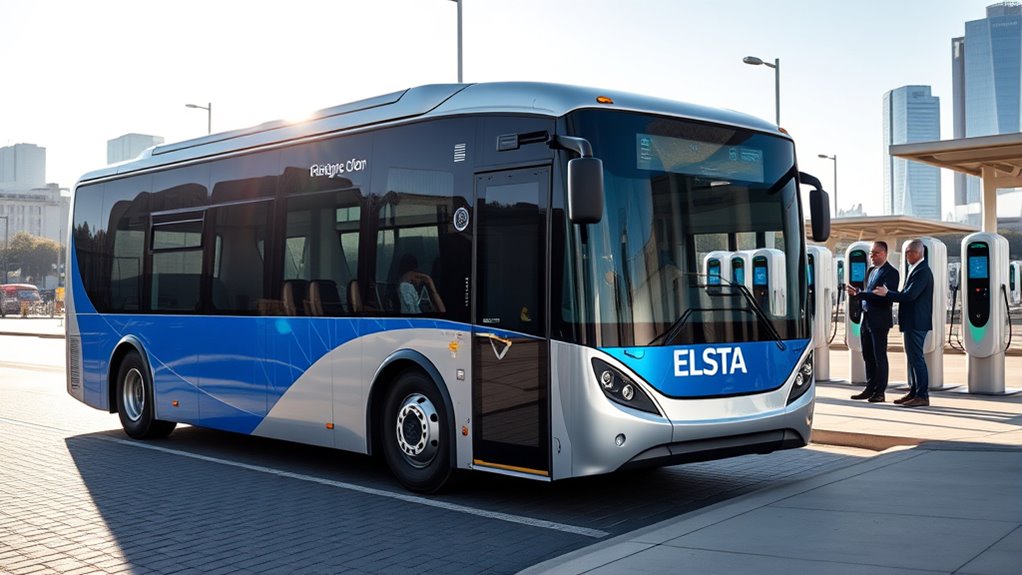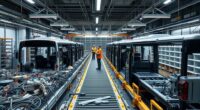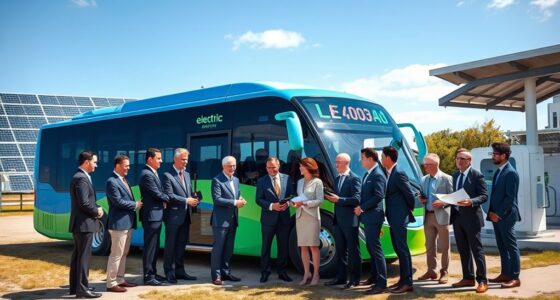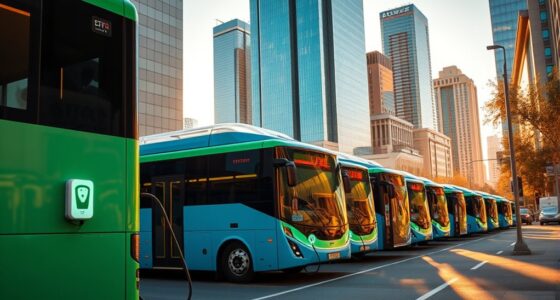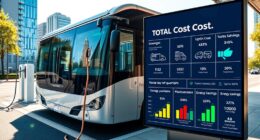Recent partnerships are transforming the electric bus industry as cities, manufacturers, and transit agencies team up to expand and improve their fleets. Cities like Rome, Hamburg, and Barcelona are collaborating with companies such as IVECO, Solaris, and Irizar to build charging infrastructure and switch to electric. Cross-border alliances and large contracts are boosting production and technological innovation across Europe. Stay with us to explore how these collaborations are shaping a cleaner, more sustainable future for public transit.
Key Takeaways
- IVECO secured a major contract with Rome, strengthening its presence through city-manufacturer collaboration.
- Hamburg committed exclusively to electric buses, partnering with Solaris and Hochbahn for fleet deployment.
- Solaris expanded its European footprint via contracts in Warsaw and Milan, supported by regional alliances.
- Hamburg partnered with Solaris and Hochbahn to develop charging infrastructure for electric fleets.
- Industry collaborations are boosting manufacturing capacity, technological innovation, and regional electric mobility expansion.
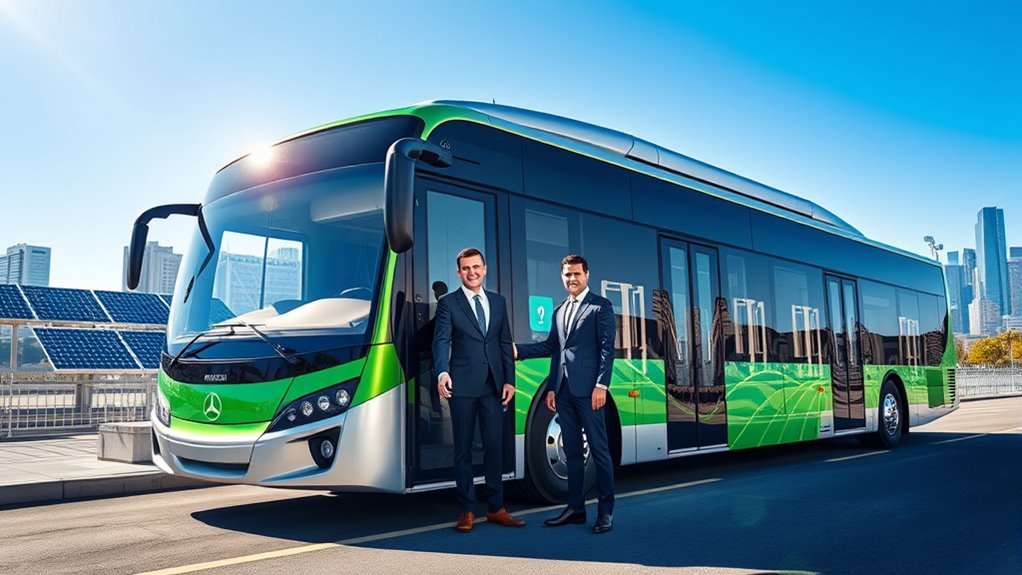
Partnerships are driving the rapid growth and innovation in the electric bus industry, transforming public transportation worldwide. These collaborations help manufacturers, cities, and technology providers accelerate the adoption of zero-emission buses, making cleaner transit more accessible and efficient.
For instance, IVECO Group recently secured a major contract with Rome, solidifying its position in the European electric bus market. This deal highlights how city governments are collaborating with manufacturers to meet ambitious sustainability goals.
Similarly, in the United States, Capital Metro joined forces with Camber, a mobility infrastructure company, to transition its fleet to electric buses. This collaboration focuses on developing charging stations and infrastructure that support large-scale electric bus operations, ensuring the transition is smooth and scalable.
Across Europe, companies like Keolis are making significant moves by awarding large orders to manufacturers like BYD. Keolis, operating in multiple countries, recently ordered 259 battery-electric buses for its European routes, demonstrating a strong commitment to sustainable mobility.
Hamburg has taken a bold step by committing exclusively to electric buses for its public transport system, working closely with manufacturers like Solaris and Hochbahn to deliver zero-emission fleets.
Solaris, in particular, has expanded its footprint by securing contracts for 130 buses in Warsaw and a framework agreement for 250 buses in Milan, exemplifying how regional alliances are fueling expansion and innovation. Additionally, strategic alliances strengthen market presence and foster technological advancements across the industry.
Manufacturers are also forming strategic alliances to strengthen their market presence. Solaris, now part of CAF after its acquisition by the Spanish group, continues to grow its European footprint with support from public transit partners.
MAN has emerged as a market leader by focusing heavily on electric bus production, setting industry standards and pushing competitors to innovate.
Wrightbus remains an essential player, especially in the UK, providing tailored electric solutions to meet specific regional needs. These collaborations boost manufacturing capacity, drive technological advancements, and help cities meet their climate commitments.
Public transportation agencies and private companies are working hand-in-hand to develop the necessary infrastructure for electric buses. In Hamburg, Hochbahn’s partnership with Solaris has led to the deployment of charging stations that accommodate the new fleet.
In Barcelona, TMB partnered with Irizar to supply electric buses, creating a seamless transition to zero-emission transit.
Frankfurt is planning to fully adopt electric buses by 2030, relying on collaborations with manufacturers and infrastructure providers to reach this goal.
Additionally, several Baltic countries have received electric buses through Solaris, illustrating how regional alliances are expanding electric mobility across borders. Such cross-border cooperation enhances overall industry growth and regional sustainability efforts.
Furthermore, the contrast ratio of these buses is a critical factor in ensuring clear visibility and safety for passengers, especially in varied lighting conditions.
Frequently Asked Questions
How Do These Partnerships Impact Electric Bus Pricing?
Partnerships play a vital role in shaping electric bus prices. They help reduce infrastructure costs through efficient planning, cutting expenses for you.
Additionally, collaborations optimize battery technology and management, lowering overall vehicle costs. By sharing resources and leveraging government incentives, these alliances enable manufacturers to scale up production, which leads to more competitive pricing.
Ultimately, partnerships help you access more affordable electric buses with improved operational efficiency and long-term savings.
Will Partnerships Improve Bus Charging Infrastructure?
Think of partnerships as the backbone holding up a bridge; they make charging infrastructure stronger and more reliable. You’ll see faster deployment, standardized hardware, and scalable designs that grow with your fleet.
Utilities and OEM collaborations reduce costs and guarantee safety, while industry alliances help avoid pitfalls. Overall, these partnerships turn a fragile system into a robust network, making charging accessible, efficient, and ready to meet your electrification goals.
Are There Plans for International Collaboration?
You’re wondering if international collaboration is in the pipeline. Yes, there are active plans to foster global partnerships. Initiatives like the US-India Electric Bus project and European alliances aim to share technology, standardize infrastructure, and reduce costs.
These collaborations help overcome financial, technological, and policy barriers, accelerating electric bus adoption worldwide. By working together, countries and companies can develop innovative solutions, expand markets, and achieve sustainability goals more effectively.
How Do Partnerships Affect Bus Model Diversity?
Did you know that partnerships can boost bus model diversity by 40%? When you engage in collaborative specs development, you guarantee grid compatibility and support a wider range of bus types.
You also benefit from joint infrastructure planning and vendor-neutral bidding, which encourage innovation and reduce vendor lock-in. These collaborations make it easier for you to test, deploy, and operate different bus models, creating a more flexible and resilient fleet.
What Are the Long-Term Sustainability Goals of These Collaborations?
You want to understand the long-term sustainability goals of these collaborations. They aim to substantially reduce carbon emissions by expanding electric bus adoption, improving infrastructure, and advancing technology.
These partnerships focus on creating cleaner, more efficient transportation systems that support environmental targets. Over time, they seek to promote equitable access, foster innovation, and ensure that sustainability becomes a core part of public transit, benefiting communities and the planet alike.
Conclusion
These new partnerships are like bridges connecting innovation and sustainability, guiding the electric bus industry toward a brighter future. By working together, you can help turn the tide against pollution and pave the way for cleaner, more efficient transportation. Remember, every collaboration is a spark that ignites progress—bringing us closer to a world where green energy drives every journey. Together, you hold the power to transform the road ahead into a path of hope and change.
